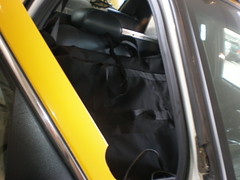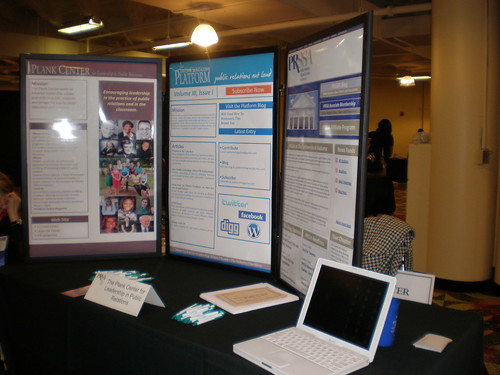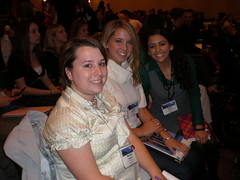Wednesday, November 19, 2008
A New Image: Cultivating Culture & Class in America
Monday, November 17, 2008
Get A Personality
- ENFJ also known as The Giver
- INTJ also known as The Scientist
- INFJ also known as The Protector
Wednesday, November 12, 2008
The Biggest Threats Facing PR
I am accustomed to thinking that there are no real threats, just challenges that are in need of adaptive approaches or strategies. If life gives you lemons, make lemonade… if life gives you oranges, make orange juice… and so forth and so on through the list of palatable fruits.
But the article about the danger of the site juicycampus.com made me think about the very real impacts of making sites available that destroy the efforts of PR. At first, you might think that putting the power in the hands of regular media consumers would be good- that it might help keep things accountable, and if something horrible happens, we simply do our jobs as usual and get things back on track.
No, sites like these have proven records of direct physical harm to the users and their families/friends. Juicy Campus has led to depression and suicidal tendencies. YouTube has fostered a subculture of users who record children beating each other up. Facebook has developed a generation of users who stalk long lost acquaintances down.
The point is not that the users themselves or the tools they use are the sole threats. The threat is that together, unchecked, unmediated, without that set of risk and strategic management skills that PR fosters, not only will we suffer as PR practitioners, but society will begin to see a degradation in moral fiber.
However, this will also hurt us directly—in the same way that the media is and has been hurting us as well through lack of proper and adequate representation or understanding of what it is we do.
In the movie “Phonebooth,” a moderately entertaining psychological thriller about a man trapped in a phone booth by a terrorist, the man claims to practice PR as a “publicist.” This man’s daily routines involve twisting the truth, bribing, manipulation and complete dishonesty in order to only be considered “small time.” He uses the words “public relations” and “publicist” very clearly.
This stereotype is reinforced in shows like “Spin City” and movies like “How to Lose a Guy in Ten Days,” often mistakenly combining the field with the field of advertising. While these are usually light-hearted and acceptable, we all know the dangers of mistaking the definition of PR from impressions on the silver screen and that PR is not “evil,” as the media may portray it. What we do not realize is its very real effect on those who don’t realize its falsity, and whom are now looking for revenge – a power put in their hands by the social networks, the online media platforms and the many blog sites available online.
We are in danger of being replaced by a subculture that does not believe we are necessary, but who do not have the facts, the training or the mindset to argue back effectively. They don’t need their facts checked, and they don’t have to care for another human being – they just have to have an agenda.
--JMS--
Monday, November 10, 2008
The PR Department... A thing of the past?
When a company’s budget gets tight, it is no secret that the public relations and advertising department is the first to get the ax. As PR students and practitioners working in the industry, it is important to be aware of potential cutbacks and actions companies take throughout the aftermath.
The Turner Broadcasting Company in Atlanta, Ga., has recently had to trim down their amount of employees. Being the successful mega-business that they are, Turner acknowledged that though the payroll was getting shorter, they still had to produce the same end results. Here enter syndication and outsourcing.
Among others, Career Sports and Entertainment was hired by Turner to create quality results equal to in-house production. Career is a private marketing agency in Atlanta, Ga., located literally down the road from the broadcasting company.
Hiring private PR, talent and/or production firms to do the work, pay the workers, package the results and deliver it to your door is more cost efficient than in-house labor. Turner has inadvertently presented some of their staff with two options: either do the work of two to three people or accept the act of outsourcing.
The efficient practice of outsourcing is nothing new. Since the Industrial Revolution, we have been searching for ways to raise productivity and profit.
However, we normally equate the topic with the global market, not the local business down the street. This traditional view of international outsourcing has shielded our eyes from local practices that, eventually, may affect your company and more importantly, your job.
Our present economy has led people to worry about their livelihoods by the masses. Outsourcing is not the most frightening practice we are experiencing, but it adds discomfort and confusion to stressful times.
The ideal situation would be to keep every employee on staff and hire private firms when projects call for collaboration or specific talents. Except, things are not looking so ideal in the big business world, and realistic adjustments are being implemented.
Whether I am a 22-year-old PR student, eager to enter the job market, or a 46-year-old company MVP, the current job cuts cause one to question her occupational future.
Will the company PR/Advertising department become a thing of the past, leaving private PR firms to reap the benefits? Or, will outsourcing plateau and become a steady, healthy practice?
Wednesday, November 5, 2008
Free Giveaways!!!
Who doesn’t love freebies?! We all do, whether it’s a pencil, bumper sticker or food. There is no better way to win over people than with free stuff. Offering anything free is a sure fire way to draw attention too. That’s what several companies did for this year’s Presidential Election.
In conjunction with the historical significance of this year’s election, several companies offered free items for those who voted. For simply voting, Starbucks offered its customers a free cup of coffee. Krispy Kreme stores rewarded voters with one star-shaped doughnut. Ben and Jerry’s gave away a free scoop of ice cream between the hours of 5-6 p.m.
The concept of freebies is nothing new, of course. However, more companies are utilizing this method as means to promote the company, to engage customers and to show social responsibility. Starbucks’ idea for offering free coffee was suggested on their online forum site, MyStarbucksIdea.com. The move by Starbucks demonstrates their move to actively engage their customers, as well as form lasting relationships with their customers.
Another company, Taco Bell, launched the campaign, Steal a Base, Steal a Taco, recently offering their customers free tacos. Taco Bell’s promotion coincided with the Major League Baseball World Series. This effort helped to promote the MLB World Series, whose viewing numbers were down, and promote Taco Bell. Collaborative campaigns such as Steal a Base, Steal a Taco often brings together two unlikely forces to meet a common goal. In addition, Dr Pepper will give away a free can of Dr Pepper to everyone in American when Gun’s N Roses releases their “Chinese Democracy” album. Dr Pepper also launched a blog in conjunction with its offer. Like Starbucks, Dr Pepper is employing social media to connect with their customers.
Freebies and giveaways provide a simple yet efficient method to increase awareness of a company. Freebies can also have a positive reflection on the company by showing social responsibility, like Ben and Jerry’s, Krispy Kreme and Starbucks. By offering free items for voters, Ben and Jerry’s, Krispy Kreme and Starbucks come across as being involved in the issues in America and show social responsibility. Furthermore, freebies can positively promote a company, and bring in new customers. Overall, freebies are a win-win situation. Everyone involved has the chance to benefit.
Brandi
Monday, November 3, 2008
WOM- A useful technique for PR?
Remember back when you were in elementary school and a rumor started at the lunch table that got passed down through 20 kids in a matter of seconds?
Well, word travels fast and people have been using the method for hundreds of years. Benjamin Franklin, the father of advertising art, first coined the term back in the 1700s when he utilized it for spreading the word about politics and new technologies.
Today, many public relations professionals are using the word-of-mouth method. PR focuses on building relationships with individuals in hopes to create a good relationship with organizations. It all has to start with one person relaying the message on to another and so on.
Social media acts as a word-of-mouth method (better known as “word-of-mouse”) whereas features utilized on the Internet spread from one person to the other in a matter of seconds. Twitter and YouTube are accessed by millions of people everyday and people are sharing the information from these social media outlets by sending them to friends and colleagues.
Some companies do not use any type of advertising and bank on their employers to spread the word. MonaVie, a company that sells the premier acai juice blend, uses the word-of-mouth method. There are no commercials, no selling in stores on shelves—only sharing of stories behind the juice. After getting on board to become a Mona Vei distributor, that person is responsible for telling others about the juice personally and giving taste testing and informational meetings on their own. No use of advertising is necessary except a virtual office for people to buy the juice on their own.
“You are sending a message not selling a product,” independent distributor Tyler Wilson said. “MonaVie wants to inform people about the health benefits of drinking this premier juice blend.” The company’s slogan is “Drink it, feel it, share it.”
It is all about sharing the message and developing relationships with clients, which is the best way from a PR standpoint. The employers are not working as salesman, but almost as public relations correspondents. Each distributor works as a liaison to the company, providing good PR in their local communities and connecting them to one big beneficial organization.
MonaVie also created their own foundation called the More Foundation that builds homes, schools and hospitals in the Amazon. It also helps preserve 25 percent of the rain forest because that is where the berries are grown and a large part of the world’s oxygen comes from there.
Another percentage (50) of the company’s profit goes to their distributors every “Good Friday,” due to its compensation plan as a new binary system. MonaVie hit the billion dollar mark in two and a half years and is the fastest growing company in history. It even took Microsoft a good 10 years before it hit the billion dollar mark.
So, is there a little something that we can learn from word-of-mouth methods? I think so, public relations has always used this technique, but not on such a large scale. There is still a big difference in relational marketing and public relations, but I think both principles combined could result in success.
Bulldog Daily Reporter- PR University offers WOM strategies in accordance to its claim that social media is changing the conventional marketing of word of mouth and is “reinventing public relations.” Bulldog also offers information on how the modern form of WOM can be incorporated into traditional PR, campaigns that “show how these techniques drive brand and the bottom line,” using “word of mouse,” finding other WOM users and how to stay up-to-date with online WOM (Second Life, Twitter and wikis).
By Stephanie S.
Tuesday, October 28, 2008
Detroit Day 3, 4 & 5 Photos
 It rode shot gun from the Hilton to the Airport!
It rode shot gun from the Hilton to the Airport! 
 Well, it was fun until I had to bring it all back to Tuscaloosa.
Well, it was fun until I had to bring it all back to Tuscaloosa. After the awards ceremony at the Detroit Institute of Art. I had no idea Detroit had such great art by Monet, Van Gough, Cassat and Degas, just to name a few.
After the awards ceremony at the Detroit Institute of Art. I had no idea Detroit had such great art by Monet, Van Gough, Cassat and Degas, just to name a few.  Our project board!! Special thanks to Jacob and all the Platform team members, it went over so well!!
Our project board!! Special thanks to Jacob and all the Platform team members, it went over so well!!  Chevy Volt, which GM made available for us to check out at our opening night social.
Chevy Volt, which GM made available for us to check out at our opening night social. 


